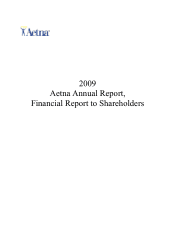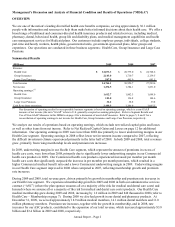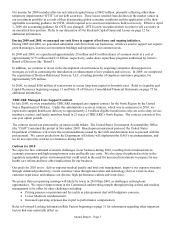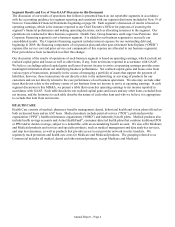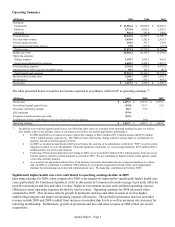Aetna 2009 Annual Report Download
Download and view the complete annual report
Please find the complete 2009 Aetna annual report below. You can navigate through the pages in the report by either clicking on the pages listed below, or by using the keyword search tool below to find specific information within the annual report.
2009
Aetna Annual Report,
Financial Report to Shareholders
Table of contents
-
Page 1
2009 Aetna Annual Report, Financial Report to Shareholders -
Page 2
-
Page 3
-
Page 4
...Chairman and Chief Executive Officer To our shareholders: 2009 was a particularly challenging year for Aetna. Like our customers and members, we experienced dynamic market forces brought on by the worst economic recession in 70 years. Driven by changes in customer preferences, employment levels and... -
Page 5
... our performance informed by a thorough analysis of the business challenges we will face as the economy begins to recover. Long term, we anticipate being able to profitably grow our already strong franchise, enabling us to break new ground in terms of new markets, products and services, both in... -
Page 6
-
Page 7
...9 Large Case Pensions - We provide a quantitative and qualitative discussion about the factors affecting Large Case Pensions operating earnings, including the results of discontinued products, in this section. 11 Investments - As an insurer, we have substantial investment portfolios that support our... -
Page 8
... health insurance products and related services, including medical, pharmacy, dental, behavioral health, group life and disability plans, and medical management capabilities and health care management services for Medicaid plans. Our customers include employer groups, individuals, college students... -
Page 9
...we issued $500 million of senior notes to secure long-term capital at favorable rates. Refer to Liquidity and Capital Resources beginning on page 13 and Note 14 of Notes to Consolidated Financial Statements on page 75 for additional information. TRICARE Managed Care Support Contract In July 2009, we... -
Page 10
... and data analytics services, and stop loss insurance, as well as products that provide access to our provider network in select markets. We separately track premiums and health care costs for Medicare and Medicaid products. The grouping referred to as Commercial includes all medical, dental and... -
Page 11
... Operating earnings for 2009, when compared to 2008, were negatively impacted by significantly higher health care costs, particularly for Commercial products (refer to discussion of Commercial results on page 6) partially offset by growth in premiums and fees and other revenue, higher net investment... -
Page 12
... of a large customer' s membership from a Commercial ASC plan to a Medicare Insured plan in 2008. The increase in 2009 was also due to increases in supplemental premiums across all of our Medicare Advantage products, rate increases from the Centers for Medicare & Medicaid Services ("CMS") and... -
Page 13
... health plans included in Commercial medical membership above. Represents members in products that allow these members access to our dental provider network for a nominal fee. Represents members who purchased medications through our mail order pharmacy operations during the fourth quarter of 2009... -
Page 14
... are working with our customers on an orderly transition of this product to other carriers. Operating Summary (Millions) Premiums: Life Disability Long-term care Total premiums Fees and other revenue Net investment income Net realized capital gains (losses) Total revenue Current and future benefits... -
Page 15
...) primarily for tax qualified pension plans. These products provide a variety of funding and benefit payment distribution options and other services. The Large Case Pensions segment includes certain discontinued products. Operating Summary (Millions) Premiums Net investment income Other revenue Net... -
Page 16
... Assets Managed by Large Case Pensions At December 31, 2009 and 2008, Large Case Pensions assets under management consisted of the following: (Millions) Assets under management: (1) Fully guaranteed discontinued products Experience-rated Non-guaranteed Total assets under management (1) 2009 $ 3,667... -
Page 17
... Debt and equity securities Mortgage loans Other investments Total investments 2009 $ 17,159.7 1,594.0 1,220.1 $ 19,973.8 2008 $ 13,993.3 1,679.9 1,196.2 $ 16,869.4 The risks associated with investments supporting experience-rated pension and annuity products in our Large Case Pensions business are... -
Page 18
... the credit and other capital markets experiencing volatility and limitations on the ability of companies to issue debt or equity securities. The lack of available credit, lack of confidence in the financial sector, increased volatility in the financial markets and reduced business activity resulted... -
Page 19
... sector exposure within our debt securities portfolio. In connection with our investment and risk management objectives, we also use derivative financial instruments whose market value is at least partially determined by, among other things, levels of or changes in interest rates (short-term or long... -
Page 20
... are reported as cash provided by investing activities). Refer to the Consolidated Statements of Cash Flows on page 47 for additional information. (Millions) Cash flows from operating activities Health Care and Group Insurance (including Corporate Financing) Large Case Pensions Net cash provided by... -
Page 21
... Moody' s Investors Service has placed Aetna' s senior debt and ALIC' s financial strength ratings under review for possible downgrade. Solvency Regulation The National Association of Insurance Commissioners (the "NAIC") utilizes risk-based capital ("RBC") standards for insurance companies that are... -
Page 22
... to health care providers or pharmacies because certain terms of these payments are not determinable at December 31, 2009 (for example, the timing and volume of future services provided under fee-for-service arrangements and future membership levels for capitated arrangements). We believe that funds... -
Page 23
... utilization and unit costs. Changes in health care practices, inflation, new technologies, increases in the cost of prescription drugs, direct-to-consumer marketing by pharmaceutical companies, clusters of high-cost cases, claim intensity, changes in the regulatory environment, health care provider... -
Page 24
... Liabilities We establish insurance liabilities other than health care costs payable for benefit claims related to our Group Insurance segment. We refer to these liabilities as other insurance liabilities. These liabilities relate to our life, disability and long-term care products. Annual Report... -
Page 25
... The liabilities for our life and disability products reflect benefit claims that have been reported to us but not yet paid, estimates of claims that have been incurred but not yet reported to us, and future policy benefits earned under insurance contracts. We develop these reserves and the related... -
Page 26
... lapse rates and the rate at which new claims are submitted to us. We estimate the future policy benefits reserve for long-term care products using these assumptions and actuarial principles. For long-duration insurance contracts, we use our original assumptions throughout the life of the policy and... -
Page 27
... for Estimated Terminations and Uncollectable Accounts) Our revenue is principally derived from premiums and fees billed to customers in the Health Care and Group Insurance businesses. In Health Care, revenue is recognized based on customer billings, which reflect contracted rates per employee and... -
Page 28
... guaranteed issue of coverage in the individual and small group market with a weak mandate that requires coverage. It would also specify required benefit designs, limit rating and pricing practices, and impose minimum requirements for medical benefit ratios, create new ways in which health insurance... -
Page 29
... the U.S. Department of Health and Human Services to issue regulations implementing its privacy and security enhancements. We will continue to assess the impact of these regulations on our business as they are issued. In 2008, the U.S. Congress reduced funding for Medicare Advantage plans beginning... -
Page 30
... payment Member rights and responsibilities Sales and marketing activities Quality assurance procedures Disclosure of medical and other information In-network and out-of-network provider rates of payment General assessments Provider contract forms Pharmacy and pharmacy benefit management operations... -
Page 31
...issuers of health insurance coverage and health benefit plan sponsors. The law authorizes the U.S. Department of Health and Human Services ("HHS") to issue standards for electronic transactions, as well as privacy and security of medical records and other individually identifiable health information... -
Page 32
... coverage through guaranteed issue requirements, and through new insurance exchanges and/or other mechanisms. At the same time, these proposals could change the underwriting and marketing practices of health plans, for example by placing restrictions on pricing and mandating minimum medical benefit... -
Page 33
... to purchase health care coverage. Allowing significantly expanded access to Medicaid, Medicare, the Federal Employees Health Benefit Plan or other government-based health insurance programs, or creating other government-run insurance programs that would compete with commercial health plans. For... -
Page 34
... San Francisco to require that City employers must either provide health benefits to their employees or pay into a City fund. This lawsuit challenges the current application of ERISA preemption to employers in their administration of benefits. Certain Large Case Pensions and Group Insurance products... -
Page 35
... Advantage plans beginning in 2010, requires health plans that offer Medicare Advantage plans to have contracts with the providers their members utilize beginning in 2011, and imposed new marketing requirements for Medicare Advantage and Medicare Part D Prescription Drug plans beginning in 2009... -
Page 36
... abuse prohibitions encompass a wide range of activities, including kickbacks for referral of members, billing for unnecessary medical services, improper marketing, and violations of patient privacy rights. Companies involved in public health care programs such as Medicare and Medicaid are often the... -
Page 37
... of disability or changing claim determination, settlement and/or payment practices, could have a material impact on our life insurance and/or disability insurance operations and/or operating results. International Regulation We continue to expand our Health Care operations that are conducted in... -
Page 38
... effect on our business, financial condition or operating results. In that case, the trading price of our common stock could decline materially. The continuing public policy debate on health reform and the stressed economic environment, with high U.S. unemployment, present overarching risks to all... -
Page 39
... small differences between predicted and actual health care costs as a percentage of premium revenues can result in significant adverse changes in our results of operations. If the rate of increase in our health care or other benefit costs in 2010 were to exceed the levels reflected in our pricing... -
Page 40
... economic conditions at the federal or applicable state level and general political issues and priorities. For example, in 2008, the U.S. Congress reduced funding for Medicare Advantage plans beginning in 2010 and imposed new marketing requirements on Medicare Advantage and Annual Report - Page... -
Page 41
... to service members of Medicare Advantage plans by 2015. Our government customers also determine the premium levels and other aspects of these programs that affect the number of persons eligible or enrolled in these programs and our administrative and health care costs under these programs. In... -
Page 42
... premium price increases despite being faced with increasing health care costs. Our customer contracts are subject to negotiation as customers seek to contain their benefit costs, particularly in a slow economy. Customers may elect to self-insure or to reduce benefits in order to limit increases... -
Page 43
... our Commercial products. There continues to be a heightened review by federal and state regulators of the health care insurance industry' s business and reporting practices, including utilization management, payment of providers with whom the payor does not have contracts and other claim payment... -
Page 44
... Medicare PDP, mail order pharmacy, specialty pharmacy and ActiveHealth. These products subject us to regulatory and other risks that are different from the risks of providing Commercial managed care and health insurance products and may increase the risks we face from litigation, regulatory reviews... -
Page 45
... to access to drugs for individuals enrolled in health care benefits plans, and restrictions on the use of average wholesale prices. The application of federal, state and local laws and regulations to the operation of our mail order pharmacy and mail order specialty pharmacy products. The risks... -
Page 46
... customers consider our products and services. Our contracts with providers generally may be terminated by either party without cause on short notice. The failure to maintain or to secure new cost-effective health care provider contracts may result in a loss in membership, higher health care costs... -
Page 47
... and 2009. As an insurer, we have a substantial investment portfolio that supports our policy liabilities and is comprised particularly of debt securities of issuers located in the U.S. As a result, the income we earn from our investment portfolio is largely driven by the level of interest rates in... -
Page 48
... investment performance, interest rate changes or changes in estimates of benefit costs, if significant, could adversely affect our operating results or financial condition by significantly increasing our pension plan expense and obligations. For example, due to market driven unfavorable investment... -
Page 49
... income Net realized capital gains (losses), net of tax Assets Short-term debt Long-term debt Shareholders' equity Per common share data: Dividends declared Income from continuing operations: Basic Diluted Net income: Basic Diluted 2009 $ 34,764.1 1,276.5 1,276.5 55.0 38,550.4 480.8 3,639.5 9,503... -
Page 50
...Health care costs have been reduced by fully insured member co-payments revenue related to our mail order and specialty pharmacy operations of $122 million, $111 million and $102 million for 2009, 2008 and 2007, respectively. Refer to accompanying Notes to Consolidated Financial Statements. Annual... -
Page 51
... taxes Other long-term assets Separate Accounts assets Total assets Liabilities and shareholders' equity: Current liabilities: Health care costs payable Future policy benefits Unpaid claims Unearned premiums Policyholders' funds Collateral payable under securities loan agreements Short-term debt... -
Page 52
...Pension and OPEB plans Other comprehensive loss Total comprehensive loss Common shares issued for benefit plans, including tax benefits Repurchases of common shares Dividends declared ($.04 per share) Balance at December 31, 2008 Cumulative effect of adopting new accounting standard at April 1, 2009... -
Page 53
... for investing activities Cash flows from financing activities: Proceeds from issuance of long-term debt, net of issuance costs Net issuance of short-term debt Deposits and interest credited for investment contracts Withdrawals of investment contracts Common shares issued under benefit plans Stock... -
Page 54
... member in the case of HSAs). We also offer Medicare and Medicaid products and services and specialty products, such as medical management and data analytics services, behavioral health plans and stop loss insurance, as well as products that provide access to our provider network in select markets... -
Page 55
...defined benefit pension and other postretirement plans in accordance with a new accounting standard issued by the FASB. This change resulted in a cumulative effect adjustment to the opening balance of shareholders' equity at January 1, 2007 comprised of a $4 million increase to retained earnings and... -
Page 56
... cash flow analysis in conjunction with comparable sales information. At the time of the sale, we record the difference between the sales price and the carrying value as a realized capital gain or loss. We make limited use of derivatives in order to manage interest rate, foreign exchange, price risk... -
Page 57
... weighted-average cost of capital. This discount rate range is consistent with that used for investment decisions and takes into account the specific and detailed operating plans and strategies of the Health Care and Group Insurance reporting units. Certain other key assumptions Annual Report - Page... -
Page 58
... fee-for-service medical, dental and pharmacy claims, capitation costs and other amounts due to health care providers pursuant to risk-sharing arrangements related to Health Care' s POS, PPO, HMO, Indemnity, Medicare and Medicaid products. Unpaid health care claims include our estimate of payments... -
Page 59
... premium deficiency reserves at December 31, 2009 or 2008. Health Care Contract Acquisition Costs Health care products included in the Health Care segment are cancelable by either the customer or the member monthly upon written notice. Acquisition costs related to our prepaid health care and health... -
Page 60
... employer groups in 2009, 2008 and 2007. Under these annual contracts, CMS pays us a portion of the premium, a portion of, or a capitated fee for, catastrophic drug costs and a portion of the health care costs for low-income Medicare beneficiaries and provides a risk sharing arrangement to limit our... -
Page 61
... in 2009 (pending the final allocation of purchase price). Of this goodwill amount, $36 million will be tax deductible. All of the goodwill related to this acquisition was assigned to our Health Care segment. Refer to Note 7 on page 57 for additional information. 4. Earnings Per Common Share Basic... -
Page 62
... health care cost estimates that was driven by what we believe was unusually high paid claims activity in the first half of 2009 related to the second half of 2008. This unfavorable development of prior year health care cost estimates offset the amount of the 2009 reduction in our estimate of health... -
Page 63
... pending the final allocation of purchase price. (Refer to Note 3 on page 55 for additional information). Approximately $5.0 billion and $104 million of goodwill was assigned to the Health Care and Group Insurance segments, respectively, at both December 31, 2009 and 2008. Other acquired intangible... -
Page 64
... of non-credit-related impairments in other comprehensive loss (as of December 31, 2009, these securities had a net unrealized capital loss of $17.2 million). Investment risks associated with our experience-rated and discontinued products generally do not impact our results of operations (refer to... -
Page 65
....4 At December 31, 2009 and 2008, debt and equity securities in an unrealized loss position of $78.2 million and $334.7 million, respectively, and with related fair value of $1.0 billion and $1.8 billion, respectively, related to discontinued and experience-rated products. Annual Report - Page 59 -
Page 66
...of companies to issue debt or equity securities. The lack of available credit, lack of confidence in the financial sector, increased volatility in the financial markets and reduced business activity resulted in credit spreads widening during 2008. For the year ended December 31, 2008, credit-related... -
Page 67
... relationships with certain real estate and hedge fund partnerships that are considered VIEs. We record the amount of our investment in these partnerships as long-term investments on our balance sheets and recognize our share of partnership income or losses in earnings. Our maximum exposure to loss... -
Page 68
...non-credit-related component of OTTI on debt securities that we do not intend to sell as well as subsequent changes in fair value related to previously impaired debt securities. Effective April 1, 2009, we adopted new accounting guidance for other-than-temporary impairments of debt securities. Refer... -
Page 69
... models such as matrix pricing, which uses quoted market prices of debt securities with similar characteristics or discounted cash flows to estimate fair value. We obtained one price for each of our Level 2 debt securities and did not adjust any of these prices at December 31, 2009. Annual Report... -
Page 70
... prices are available for these securities in an active market. For privately-held equity securities, there is no active market; therefore, we classify these securities as Level 3 because we must price these securities through an internal analysis of each investment' s financial statements and cash... -
Page 71
... at adjusted cost or contract value. Mortgage loans - Fair values are estimated by discounting expected mortgage loan cash flows at market rates that reflect the rates at which similar loans would be made to similar borrowers. These rates reflect management' s assessment of the credit quality and... -
Page 72
...) of the reporting period. In 1996, we entered into a contract with UBS Realty Investors, LLC (formerly known as Allegis Realty Investors, LLC) under which mortgage loan and real estate separate account assets and corresponding liabilities transitioned out of our business. Annual Report - Page 66 -
Page 73
... supplemental cash balance accounts and the plan may continue to be used to credit special pension arrangements. In addition, we currently provide certain medical and life insurance benefits for retired employees, including those of our former parent company. We provide subsidized health benefits to... -
Page 74
...assets and the plan' s benefit obligation is referred to as the plan' s funded status. This funded status is an accounting-based calculation and is not indicative of our mandatory funding requirements, which are described on page 69. The funded status of our pension and OPEB plans at the measurement... -
Page 75
...4.51 2009 6.92% 5.50 OPEB Plans 2008 6.35% 5.50 2007 5.82% 5.50 - Discount rate Expected long-term return on plan assets Rate of increase in future compensation levels We assume different health care cost trend rates for medical costs and prescription drug costs in estimating the expected costs of... -
Page 76
... real estate Total equity securities and common/collective trusts Other investments: Real estate Other assets Total investments (1) (1) Level 1 Level 2 Level 3 Total Excludes $123.0 million of cash and cash equivalents and other receivables. The changes in the balances of Level 3 Pension... -
Page 77
... our long-term 8.50% return assumption would impact our annual pension costs by approximately $5 million after tax and would have a negligible effect on our annual OPEB costs. 401(k) Plan Substantially all of our employees are eligible to participate in a defined contribution retirement savings plan... -
Page 78
... of RSUs and PSUs are based on the market price of our common stock on the date of grant. We estimate the fair value of stock options and SARs using a modified Black-Scholes option pricing model. SARs granted in 2009, 2008 and 2007 had a weighted average per share fair value of $11.37, $14.71, and... -
Page 79
... options with newly-issued common stock and generally utilize the proceeds to repurchase common stock in the open market in the same period. The following is a summary of information regarding stock options and SARs outstanding and exercisable at December 31, 2009 (number of stock options and SARs... -
Page 80
...Deferred tax assets: Reserve for anticipated future losses on discontinued products Employee and postretirement benefits Investments, net Deferred policy acquisition costs Unrealized losses on investment securities Insurance reserves Other Gross deferred tax assets Less: Valuation allowance Deferred... -
Page 81
... borrowings mature on the termination date of the Facility. We pay facility fees on the Facility ranging from .045% to .175% per annum, depending upon our long-term senior unsecured debt rating. The facility fee was .06% at December 31, 2009. The Facility contains a financial covenant that requires... -
Page 82
...the Board declared an annual cash dividend of $.04 per common share to shareholders of record at the close of business on November 13, 2009. The $17.3 million dividend was paid on November 30, 2009. In addition to the capital stock disclosed on our balance sheets, we have authorized 8 million shares... -
Page 83
... funds on our balance sheets. Assets related to and supporting these policies were transferred to the assuming companies, and we recorded a reinsurance recoverable. Effective November 1, 1999, we reinsured certain policyholder liabilities and obligations related to paid-up group whole life insurance... -
Page 84
... purported class actions and individual lawsuits arising out of our practices related to the payment of claims for services rendered to our members by health care providers with whom we do not have a contract ("out-of-network providers"). Other major health insurers are also the subject of similar... -
Page 85
... to be heightened review by regulatory authorities of and increased litigation regarding the health care benefits industry' s business and reporting practices, including utilization management, complaint and grievance processing, information privacy, provider network structure (including the... -
Page 86
... $16 million, respectively. 19. Segment Information Our operations are conducted in three business segments: Health Care, Group Insurance and Large Case Pensions. Our Corporate Financing segment is not a business segment. It is added to our business segments in order to reconcile to our consolidated... -
Page 87
... is on a closed block of paid-up group whole life insurance business. ï,· In 1993, we discontinued the sale of our fully guaranteed large case pension products and established a reserve for anticipated future losses on these products, which we review quarterly. Changes in this reserve are recognized... -
Page 88
... a receivable from Large Case Pensions' continuing products (which is eliminated in consolidation). Key assumptions in setting this reserve include future investment results, payments to retirees, mortality and retirement rates and the cost of asset management and customer service. In 1997... -
Page 89
... equity securities available-for-sale Mortgage loans Other investments Total investments Other assets Collateral received under securities loan agreements Current and deferred income taxes Receivable from continuing products (2) Total assets Liabilities: Future policy benefits Policyholders' funds... -
Page 90
...) Scheduled contract maturities, settlements and benefit payments Participant-directed withdrawals 2009 447.1 .2 $ 2008 454.3 .1 $ 2007 468.0 .3 $ Cash required to fund these distributions was provided by earnings and scheduled payments on, and sales of, invested assets. Annual Report - Page... -
Page 91
... of changes in conditions, or that the degree of compliance with policies or procedures may deteriorate. Under the supervision and with the participation of management, including our Chief Executive and Chief Financial Officers, management assessed the effectiveness of our ICOFR at December 31, 2009... -
Page 92
... Plaza Hartford, CT 06103-4103 Report of Independent Registered Public Accounting Firm The Board of Directors and Shareholders Aetna Inc.: We have audited the accompanying consolidated balance sheets of Aetna Inc. and subsidiaries (the "Company") as of December 31, 2009 and 2008, and the related... -
Page 93
...consolidated financial statements, effective April 1, 2009, the Company changed its method of accounting for other-than-temporary impairments of debt securities due to the adoption of new accounting guidance issued by the Financial Accounting Standards Board. February 26, 2010 Annual Report - Page... -
Page 94
... December 31, 2009. The graph assumes a $100 investment in shares of our common stock on December 31, 2004. (1) At December 31, 2009, the companies included in the MSHPI were: Aetna Inc., Amerigroup Corporation, Centene Corporation, CIGNA Corporation, Coventry Health Care, Inc., Health Net, Inc... -
Page 95
...Service Operations Robert M. Mead Senior Vice President Marketing, Product and Communications Lonny Reisman, M.D. Senior Vice President and Chief Medical Officer Elease E. Wright Senior Vice President Human Resources Joseph M. Zubretsky Executive Vice President and Chief Financial Officer Corporate... -
Page 96
..., officers and employees (and information regarding any amendments or waivers relating to Aetna' s Directors, executive officers and principal financial and accounting officers or persons performing similar functions); Independence Standards for Directors; Corporate Governance Guidelines; Board of... -
Page 97
... dividend checks, address changes, stock transfers and other account matters. DirectSERVICE Investment Program Current shareholders and new investors can purchase Aetna common shares and reinvest cash dividends through this program sponsored by Computershare. Contacting Computershare by mail... -
Page 98
...Shareholder Inquiries Office of the Corporate Secretary Aetna Inc. 151 Farmington Avenue, RW61 Hartford, CT 06156-3215 Fax: 860-293-1361 E-mail address: [email protected] Aetna Equity-Based Grant Participants and Aetna Employee Stock Purchase Plan Participants Employees with outstanding... -
Page 99
-
Page 100
www.aetna.com Annual Report - Page 5

